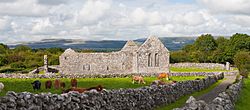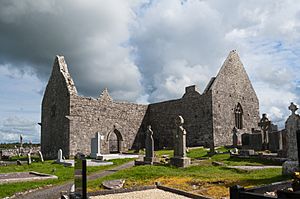Kilmacduagh monastery facts for kids

Augustinian Abbey of St. Mary de Petra, erected in the 13th century
|
|
| Monastery information | |
|---|---|
| Established | 7th century |
| Diocese | Kilmacduagh |
| People | |
| Founder(s) | reportedly Colman MacDuagh |
| Architecture | |
| Status | ruined |
| Heritage designation | National Monument No. 51 |
| Groundbreaking | original structures 7th century |
| Site | |
| Location | near Gort, County Galway, Ireland |
| Coordinates | 53°02′58″N 8°53′15″W / 53.049444°N 8.8875°W |
| Public access | yes |
| Official name | Kilmacduagh monastery |
| Reference no. | 51 |
Kilmacduagh Monastery is an old, ruined abbey located near Gort in County Galway, Ireland. It was once a very important religious center. It's believed that Saint Colman, son of Duagh, started this monastery in the 600s. He built it on land given to him by his cousin, King Guaire Aidne mac Colmáin of Connacht.
Contents
About Kilmacduagh Monastery
Kilmacduagh Monastery is found in a small village that shares its name. This village is about 5 kilometers (3 miles) from the town of Gort.
The name "Kilmacduagh" means "church of Duagh's son." It refers to Saint Colman, who founded the monastery. King Guaire Aidne mac Colmáin gave him the land. The king had a strong home nearby, where Dunguaire Castle stands today.
A Look Back: History of the Monastery
The exact year the monastery was founded is not certain. However, most experts believe it was built in the early 600s.
Saint Colman was the leader, or abbot/bishop, of the monastery until he died. Only one other leader, named Indrect, is mentioned in old records before the English arrived. He died in the year 814.
This site became very important in the Middle Ages. In the 1100s, it became the center of a new church area called the Diocese of Kilmacduagh. This means it was where the local bishop had his main church.
The first monastery was attacked many times. It was finally ruined by William de Burgh in the early 1200s. To replace it, a local lord named Owen O'Heyne started a new abbey. This was the Abbey of St. Mary de Petra, built for Augustinian canons. Some also say Bishop Maurice Ileyan helped build it. Later, during a time of big changes in the church, the abbey was given to the Earl of Clanricarde.
The famous round tower at Kilmacduagh was fixed in 1879. Sir Thomas Deane oversaw the repairs. Money for the work came from Sir William Henry Gregory.
Today, the Diocese of Kilmacduagh is part of the larger Diocese of Galway.
What You Can See Today
The ruins of Kilmacduagh Monastery are sometimes called "the seven Churches." But not all of these buildings were churches. Also, none of them are from the original 600s monastery. The buildings you can see include:
- The main abbey church, which was once the cathedral, called Teampuil Mor. It's in the graveyard.
- The "Church of Mary," or Teampuil Muire, located east of the road.
- The "Church of St. John the Baptist," or Teampuil Eoin Baiste, to the north of the graveyard.
- The "Abbot's House," or Seanclogh, further north and close to the road.
- Teampuil Beg Mac Duagh, found south of the graveyard.
- The "Monastery Church," also known as "O'Heyne's Church" or "O'Heyne's Abbey." This one is about 180 meters (590 feet) north-east of the graveyard and was built in the 1200s.
- The round tower, which stands about 15 meters (49 feet) south-west of the cathedral.
The round tower is very special. It's a great example of these unique Irish towers. It's also famous because it leans quite a bit, more than half a meter (about 20 inches) off straight! The tower is over 30 meters (100 feet) tall. Its only doorway is about 7 meters (23 feet) above the ground. This tower likely dates back to the 900s.
Interesting Legends
There are some cool stories about Kilmacduagh.
One legend says that Saint Colman MacDuagh was walking through the woods of the Burren. His belt, called a girdle, fell to the ground. He took this as a sign from above and decided to build his monastery right there. People said the girdle was covered in gems. Centuries later, a family called the O'Shaughnessys kept it. They also had St. Colman's crozier, which is a special staff. The girdle was later lost, but the crozier was held by the O'Heynes family. You can now see it in the National Museum of Ireland.
Another legend says that no one in the Diocese of Kilmacduagh will ever die from lightning. This story was tested once when someone was struck by lightning. But the bolt was so strong that it threw him into the next county, County Clare, where he then died. So, the legend remained true for the diocese!
See also
 In Spanish: Monasterio de Kilmacduagh para niños
In Spanish: Monasterio de Kilmacduagh para niños




